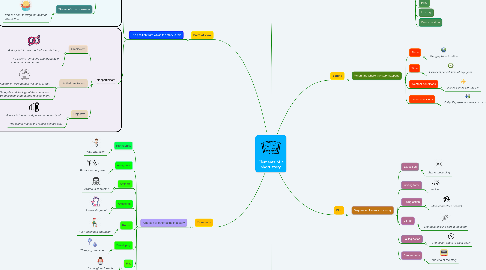
1. Characters
1.1. A person or other being in a story
1.1.1. Protagonist
1.1.1.1. Main character
1.1.2. Antagonist
1.1.2.1. Protagonist opposer
1.1.3. Antihero
1.1.3.1. Villainous character
1.1.4. Archetype
1.1.4.1. Universal symbol
1.1.5. Round
1.1.5.1. Fully described character
1.1.6. Developing
1.1.6.1. Changing character
1.1.7. Flat
1.1.7.1. Unchanging character
1.1.8. Dynamic
1.1.8.1. Changing personality
1.1.9. Static
1.1.9.1. Stereotype
2. Point of view
2.1. The position from which the story is told
2.1.1. Participant
2.1.1.1. First person
2.1.1.1.1. A story in the first person (I, we, etc.)
2.1.1.1.2. The person experiences it.
2.1.1.2. Innocent eye
2.1.1.2.1. The character may be a child.
2.1.1.3. Stream of consciousness
2.1.1.3.1. You can see through the mind of characters.
2.1.2. Nonparticipant
2.1.2.1. Omniscient
2.1.2.1.1. A story in third person (he/ she, his /her )
2.1.2.1.2. The actions, emotions and thoughts of characters can be read.
2.1.2.2. Limited omniscient
2.1.2.2.1. A story in third person (he, she, it, etc.)
2.1.2.2.2. Thoughts and feelings of the characters are only seen if the author reveals them.
2.1.2.3. Objective
2.1.2.3.1. A story in the second person pronoun ''you''.
2.1.2.3.2. The author makes the reader a character.
3. Plot
3.1. Sequence of events in a story
3.1.1. Exposition
3.1.1.1. Story's beginning
3.1.2. Inciting force
3.1.2.1. Incident
3.1.3. Rising action
3.1.3.1. Main character's conflict
3.1.4. Climax
3.1.4.1. The most exciting part in the story
3.1.5. Falling action
3.1.5.1. The action starts to calm down
3.1.6. Denouement
3.1.6.1. The end of the story
4. Setting
4.1. When and where the story happens
4.1.1. Place
4.1.1.1. Geographical location
4.1.2. Time
4.1.2.1. Historical period, time of day, year
4.1.3. Weather conditions
4.1.3.1. Rainy, sunny, stormy, etc.
4.1.4. Social conditions
4.1.4.1. Daily life, speech, dress,customs,etc.
5. Theme
5.1. The message about life left by the story
5.1.1. emphasized by
5.1.1.1. Literary devices
5.1.1.1.1. Symbolism
5.1.1.1.2. Allusion
5.1.1.1.3. Simile
5.1.1.1.4. Metaphor
5.1.1.1.5. Hyperbole
5.1.1.1.6. Irony
5.1.1.1.7. Imagery
5.1.1.1.8. Personification
6. Conflict
6.1. A problem faced by characters in the story
6.1.1. External conflict
6.1.1.1. With an outside force
6.1.2. Internal conflict
6.1.2.1. With oneself (decisions, pain, etc.)
